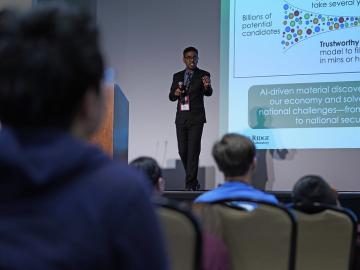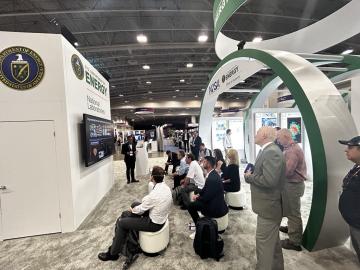
Filter News
Area of Research
News Type
News Topics
- (-) Artificial Intelligence (49)
- (-) Biology (61)
- (-) Energy Storage (36)
- (-) Fossil Energy (4)
- (-) Mercury (7)
- (-) Microscopy (23)
- (-) Nanotechnology (20)
- (-) Polymers (11)
- (-) Security (12)
- (-) Space Exploration (12)
- (-) Transportation (32)
- 3-D Printing/Advanced Manufacturing (46)
- Advanced Reactors (9)
- Big Data (30)
- Bioenergy (52)
- Biomedical (30)
- Biotechnology (13)
- Buildings (25)
- Chemical Sciences (29)
- Clean Water (15)
- Climate Change (55)
- Composites (9)
- Computer Science (92)
- Coronavirus (18)
- Critical Materials (6)
- Cybersecurity (14)
- Decarbonization (50)
- Education (1)
- Emergency (2)
- Environment (111)
- Exascale Computing (27)
- Frontier (26)
- Fusion (33)
- Grid (27)
- High-Performance Computing (45)
- Hydropower (5)
- Isotopes (29)
- ITER (2)
- Machine Learning (23)
- Materials (45)
- Materials Science (56)
- Mathematics (7)
- Microelectronics (3)
- Molten Salt (1)
- National Security (45)
- Net Zero (8)
- Neutron Science (52)
- Nuclear Energy (61)
- Partnerships (19)
- Physics (35)
- Quantum Computing (21)
- Quantum Science (32)
- Renewable Energy (1)
- Simulation (32)
- Software (1)
- Statistics (1)
- Summit (31)
- Sustainable Energy (50)
- Transformational Challenge Reactor (3)
Media Contacts

At ORNL, a group of scientists used neutron scattering techniques to investigate a relatively new functional material called a Weyl semimetal. These Weyl fermions move very quickly in a material and can carry electrical charge at room temperature. Scientists think that Weyl semimetals, if used in future electronics, could allow electricity to flow more efficiently and enable more energy-efficient computers and other electronic devices.

Two ORNL teams recently completed Cohort 18 of Energy I-Corps, an immersive two-month training program where the scientists define their technology’s value propositions, conduct stakeholder discovery interviews and develop viable market pathways.

Researchers at the Department of Energy’s Oak Ridge National Laboratory and partner institutions have launched a project to develop an innovative suite of tools that will employ machine learning algorithms for more effective cybersecurity analysis of the U.S. power grid.

Brian Sanders is focused on impactful, multidisciplinary science at Oak Ridge National Laboratory, developing solutions for everything from improved imaging of plant-microbe interactions that influence ecosystem health to advancing new treatments for cancer and viral infections.

ORNL's Guang Yang and Andrew Westover have been selected to join the first cohort of DOE’s Advanced Research Projects Agency-Energy Inspiring Generations of New Innovators to Impact Technologies in Energy 2024 program. The program supports early career scientists and engineers in their work to convert disruptive ideas into impactful energy technologies.

Researchers at ORNL and the University of Maine have designed and 3D-printed a single-piece, recyclable natural-material floor panel tested to be strong enough to replace construction materials like steel.

Prasanna Balaprakash, a national leader in artificial intelligence, or AI, spoke to some of the highest achieving students in the country at the National Science Bowl in Washington D.C.

When Oak Ridge National Laboratory's science mission takes staff off-campus, the lab’s safety principles follow. That’s true even in the high mountain passes of Washington and Oregon, where ORNL scientists are tracking a tree species — and where wildfires have become more frequent and widespread.

ORNL researchers and communications specialists took part in the inaugural AI Expo for National Competitiveness in Washington D.C, May 7 and 8, to showcase and provide insight into how the lab is leading the way for utilizing the vast possibilities of AI.

John Lagergren, a staff scientist in Oak Ridge National Laboratory’s Plant Systems Biology group, is using his expertise in applied math and machine learning to develop neural networks to quickly analyze the vast amounts of data on plant traits amassed at ORNL’s Advanced Plant Phenotyping Laboratory.


